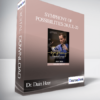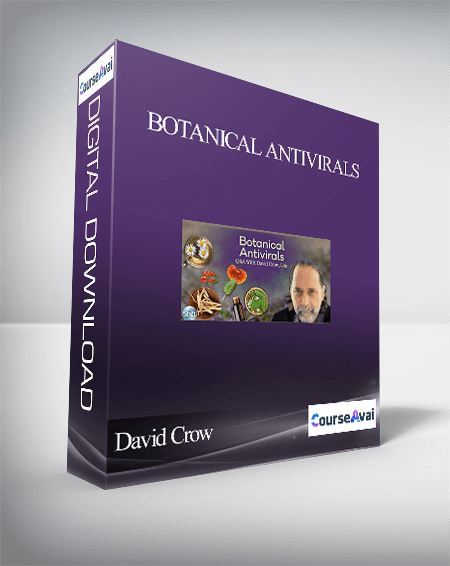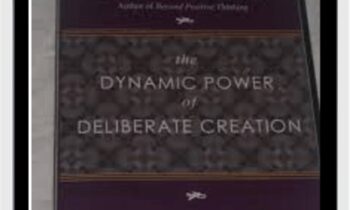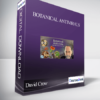$297.00 Original price was: $297.00.$56.00Current price is: $56.00.
What You’ll Discover in These 5 Weeks
In this 5-week transformational intensive, David will guide you through the fundamental skills and competencies you’ll need to successfully use herbal remedies and clinical-level formulas to address viral conditions and create your healthiest life.
Module 1: The Fragrant Pharmacy — Antiviral Powers of Aromatic Herbs & Spices (May 13)
Botanical antivirals are not necessarily rare species known only to herbalists. Some of the most potent compounds are found in common culinary herbs and spices.
 Purchase this course you will earn 56 Points worth of $5.60
Purchase this course you will earn 56 Points worth of $5.60Elevate your skills with the Botanical Antivirals With David Crow course, available for just $297.00 Original price was: $297.00.$56.00Current price is: $56.00. on Utralist.com! Browse our curated selection of over 60,000 downloadable digital courses across diverse Hypnosis and NLP. Benefit from expert-led, self-paced instruction and save over 80%. Start learning smarter today!
What You’ll Discover in These 5 Weeks
In this 5-week transformational intensive, David will guide you through the fundamental skills and competencies you’ll need to successfully use herbal remedies and clinical-level formulas to address viral conditions and create your healthiest life.
Module 1: The Fragrant Pharmacy — Antiviral Powers of Aromatic Herbs & Spices (May 13)
Botanical antivirals are not necessarily rare species known only to herbalists. Some of the most potent compounds are found in common culinary herbs and spices.
Purchase Botanical Antivirals With David Crow courses at here with PRICE $297 $56
 Botanical Antivirals With David Crow
Botanical Antivirals With David Crow
What You’ll Discover in These 5 Weeks
In this 5-week transformational intensive, David will guide you through the fundamental skills and competencies you’ll need to successfully use herbal remedies and clinical-level formulas to address viral conditions and create your healthiest life.
Module 1: The Fragrant Pharmacy — Antiviral Powers of Aromatic Herbs & Spices (May 13)
Botanical antivirals are not necessarily rare species known only to herbalists. Some of the most potent compounds are found in common culinary herbs and spices.
Knowing how to use these plants in your diet for protection against viral infections is only the beginning of utilizing their powers.
As you’ll discover, they can also be used in a variety of targeted and highly therapeutic ways to treat both acute and chronic conditions caused by a variety of virus species.
In this module, you’ll explore:
Scientific research that validates the healing effects of antiviral herbs within the human body
The difference between in-vitro and in-vivo research, and what’s relevant and applicable in scientific studies on antiviral herbs
Antiviral herbs that should be used in your daily diet for both protection and treatment
Herbs that you likely have in your kitchen right now — with known antiviral powers
The important antiviral compounds found in common herbs and spices, such as Rosmarinic acid in rosemary, mint, and lemon balm
Traditional uses of herbs such as thyme, tulsi, sages, and ginger for contagious respiratory conditions, and the modern research confirming their antiviral powers
Key differences between botanical antivirals and antiviral drugs
An overview of the antiviral mechanisms of botanical species
How classical Chinese medicine and Ayurvedic medicine view viral infections and their treatments
Module 2: Nourishing the Essence — Immune Boosting & Antiviral Powers of Adaptogens (May 20)
Adaptogenic herbs are gaining more and more recognition and popularity for their abilities to nourish, balance, and strengthen the immune, nervous, and endocrine systems, thereby increasing vitality and resistance to stress and toxins.
These herbs also possess significant antiviral powers and are therefore of primary importance for not only boosting immunity against contagious viral infections, but also speeding recovery from acute infections, and overcoming the weakening effects of chronic infections
In this module, you’ll explore:
How adaptogens are used by medical herbalists to treat virus species such as herpes and Epstein Barr, and viral conditions such as influenza and hepatitis
The antiviral activities and mechanisms of adaptogenic herbs such as licorice, rhodiola, and astragalus against various viral species
Preparation methods, correct dosages, and safe, effective combinations of adaptogens and other antiviral herbs
Major species of accessible medicinal mushrooms known for their antiviral effects, such as chaga, maitake, and turkey tail
Scientific research studies confirming the powers of botanical antivirals herbs
Module 3: The Power of Bitter — Alkaloid-Based Botanicals With Antiviral Properties (May 27)
Some of the strongest antiviral herbs are those that contain berberine and other alkaloids. These herbs have broad-spectrum antimicrobial powers, and they can be targeted to specific organs, as needed, through herbal combinations.
Because of their potency and possible adverse reactions if taken for too long or in higher dosages, these species are the most challenging to use clinically. Skillful formulation and consideration of the individual’s constitution and digestive power is required.
When carefully used, these herbs can be as effective or more so than antiviral drugs, and in some cases are gaining recognition as being able to inhibit and eradicate multidrug resistance strains of microbes.
In this module, you’ll explore:
Secrets to combining immune-boosting and antiviral herbs — for holistic treatment and protection
How to safely use potent antiviral herbs such as neem, coptis, and goldenseal
Emerging multidrug resistance and the use of antiviral herbs to support and potentize medications
Overview of the major viral species
Formulas for supporting detoxification from viral inflammation
Module 4: Protecting the Lungs — Herbs & Essential Oils With Antiviral Powers for the Respiratory System (June 3)
There are numerous herbs and essential oils with antiviral powers that are used for treating respiratory infections. As with other categories of botanical antivirals, modern research is confirming what classical medicine has known for centuries, while also revealing the biological and cellular mechanisms responsible for their actions.
The classical formulas of Chinese and Ayurvedic medicine, combined with contemporary aromatherapy, are a rich repository of valuable knowledge. Applying this knowledge for clinical level self-care is more relevant than ever for protecting ourselves from microbial contagion, lessening the severity of infections, and speeding the healing processes.
In this module, you’ll explore:
Emerging research of botanical species showing proven or potential powers against viruses, and how this can be applied for clinical-level self-care
Modern applications and scientific confirmation of classical Chinese herbal formulas for contagious respiratory diseases
The mechanisms of how essential oils work against viruses
Highly effective aromatherapy treatments for respiratory viral infections
How to create antiviral formulas for the respiratory system using herbs such as andrographis, osha, yerba santa, self-heal, and myrrh
Module 5: Clinical Pearls — Lesser-Known Antiviral Herbs Used in Clinical Herbology (June 10)
Many species of botanical antivirals are not generally found outside of the clinical practices of medical herbalists. Many of these species are underappreciated local plants that are widely available, and therefore represent an easily accessible addition to your home pharmacy.
Unlike the culinary herbs and adaptogens that can be used for extended times as part of the diet, these herbs tend to be more potent and therefore require a greater level of knowledge to be used safely and effectively. These herbs are often found in Asian medicine, and are also emerging through modern research as important sources of antiviral compounds.
In this module, you’ll explore:
Old European herbal remedies with modern antiviral applications
How to create a home pharmacy of lesser-known antiviral herbs that can be easily cultivated and wildcrafted
Major antiviral herbs for your home pharmacy including houttuynia, isatis, red root, and others
How classical Chinese medicine and Ayurvedic medicine view viral infections and their treatments
New science in herb-drug interactions: the future of antiviral treatment using combined allopathic and herbal medicines …
Purchase Botanical Antivirals With David Crow courses at here with PRICE $297 $56
Cultivate continuous growth with the Botanical Antivirals With David Crow course at Utralist.com! Unlock lifetime access to premium digital content, meticulously designed for both career advancement and personal enrichment.
- Lifetime Access: Enjoy limitless access to your purchased courses.
- Exceptional Value: Benefit from savings up to 80% on high-quality courses.
- Secure Transactions: Your payments are always safe and protected.
- Practical Application: Gain real-world skills applicable to your goals.
- Instant Accessibility: Begin your learning journey immediately after buying.
- Device Compatible: Access your courses seamlessly on any device.
Transform your potential with Utralist.com!
Related products
Hypnosis and NLP
= 133 Points
Hypnosis and NLP
= 83 Points
Hypnosis and NLP
= 21 Points
Hypnosis and NLP
= 235 Points
Hypnosis and NLP
Biology and Human Behavior, The Neurological Origins of Individuality, 2nd Edition – Robert Sapolsky
= 48 Points
Hypnosis and NLP
= 23 Points
Hypnosis and NLP
= 43 Points
Hypnosis and NLP
Dynamic Power Of Deliberate Creation (2006) – Robert Anthony
= 15 Points




 Botanical Antivirals With David Crow
Botanical Antivirals With David Crow







